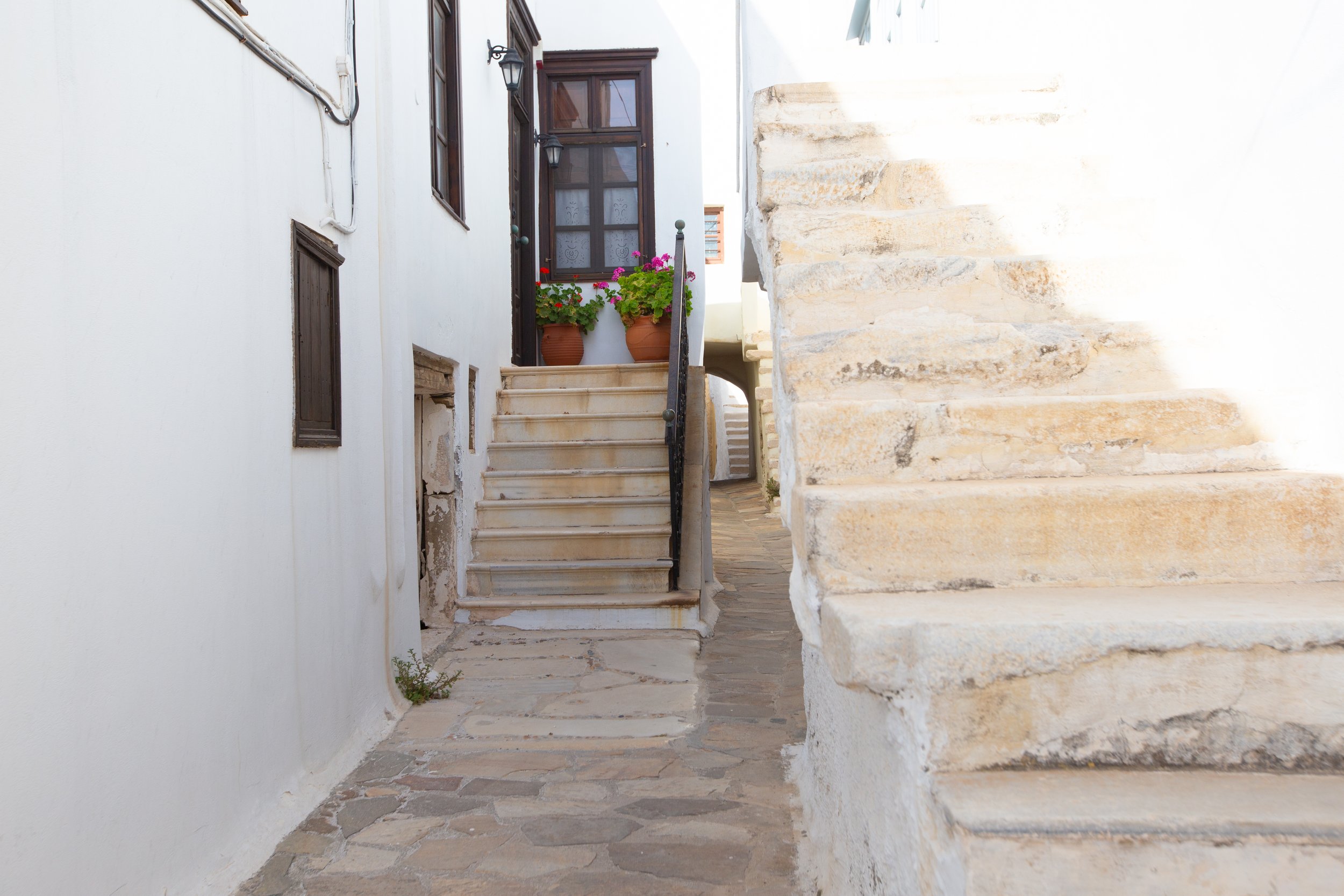Drinking Tap Water Here | Naxos
Chora – Naxos
When you think of Greek islands, Santorini’s breathtaking sunsets and Mykonos’ vibrant nightlife might come to mind. But Greece isn’t just a postcard from those two famous spots. No. Unbeknownst to me, Greece boasts a sprawling archipelago of 6,000 islands, of which 227 are inhabited. These islands are neatly categorized into clusters: the Argo-Saronic Islands near Athens, the Cyclades in the central Aegean, the North Aegean Islands west of Turkey, the Dodecanese southeast of Crete, the Sporades near Euboea, and the Ionian Islands to the west of the mainland. Crete and Euboea are usually left out of these groupings. So, to find an island to explore is daunting work. One could spend a lifetime exploring these islands.
Street art in Chora, Naxos near Apostolis restaurant
We chose to visit Naxos, one of those under-the-radar jewels, a short 40-minute flight from Athens and part of the Cyclades group of islands along with its more famous siblings, Santorini and Mykonos.
Upon arrival at our hotel, I was gearing up for a run when we were handed a critical piece of advice: “Don’t drink the tap water here.” Great, right? Just what you want to hear when you’re on an island where sustainability is already questionable. Islands, with their idyllic charm, always stir up a mix of fascination and apprehension. I love their beauty, but I can’t help but fret about their resources—where does their food come from? How do they manage their water? What about their energy? So, armed with a bottle of plastic water and a dash of trepidation, I set out to explore Naxos.
View from the Venetian Castle
Naxos, unlike its more famous Cyclades cousins, has an understated charm. We were staying near Agios Prokopios Beach, so my run took me through a maze of restaurants and cafes, including the one where I finally had my first souvlaki pita apola. From there, I headed toward the Agios Prokopios Viewpoint, perched at the island’s western edge. Here, the view was nothing short of spectacular: Paros Island shimmered across the water to the west, while the Cycladic whitewashed homes dotted the hills and valleys of Naxos to the east. The history of the whitewashed Greek island home is rather fascinating. The whitewashed homes of Greece, particularly in the Cyclades, originated as a practical response to the harsh Mediterranean climate. The tradition dates back to ancient times when locals used a mixture of lime and water to coat their homes. This whitewash not only reflects the intense sunlight, keeping interiors cooler, but also acts as a natural antiseptic, preventing the growth of mold and mildew in the humid environment. Over the centuries, what started as a pragmatic solution evolved into a hallmark of Greek island architecture. The result is the stunning, postcard-perfect aesthetic that defines the Greek islands today. Gleaming white facades stand in striking contrast against the vibrant blue of the sea and sky. Add to that the burst of color from bougainvillea draping over the walls, and you have a scene that draws admirers from around the globe.
The Alleys of Chora, Naxos
It was hot so I paused to drink from my plastic bottle, and in that moment the stark contrast between Naxos and the more crowded islands became clear.
We’d chosen Naxos over the glitzy Santorini and the party-central Mykonos for good reason. Mykonos, with its luxury and nightlife, is a no-go for families with toddlers. Thanks Kai! Santorini, on the other hand, is a victim of its own success. The island, which typically hosts about 15,000 residents, is overrun by 2 million tourists annually. Imagine this: a cruise ship docks, offloading thousands of visitors who then flood the narrow alleys, all vying for that iconic sunset photo. The locals are left to navigate these clogged streets and deal with astronomical rent hikes. It’s a tourism-induced nightmare, where residents are effectively priced out of their own homes.
The irony isn’t lost on me. Here I am, an avid traveller myself , grappling with the delicate balance between economic gain and cultural preservation. This dilemma isn’t unique to Greece; it’s a global phenomenon. Just weeks after writing this in Barcelona erupted in protests over similar issues.
The Temple of Apollo - The Portara (6th–7th century BC) guarding Naxos
As I continued my run, my thoughts meandered like the winding paths beneath my feet. Running, akin to meditation, offers a steady stream of mental recalibration. As I rounded a bend, the view of Naxos port emerged, dominated by the Portara—the massive marble gate from the 6th–7th century BC. This ancient lintel, once part of Lygdamis’ Temple of Apollo, stands as a timeless sentinel, framing the town’s white-washed homes against the horizon. My wife playfully suggested that if we ever built a house, we should use Naxian marble for the countertops.
In that golden hour, with the sun casting its final rays, I realized that my run through these breathtaking landscapes was also a journey through layers of history, culture, and modern-day conundrums. The islands’ charm is undeniable, yet they come with their own set of challenges. As much as I am drawn to their beauty, I grapple with the impact of my presence on these delicate havens.
Back at the hotel, a glass of red wine and the sunset over the Mediterranean offered a brief escape from these thoughts. As I savored the rich, hearty moussaka, I couldn’t help but think, “this is a heavy dish!”





